![[Metroactive Features]](/features/gifs/feat468.gif)
[ Features Index | San Jose | Metroactive Central | Archives ]
My Own Private Aloha
The Bay Area hosts the largest population of transplanted Hawaiians on the mainland. And despite the many cultural contrasts here, somehow they're keeping the spirit of aloha alive.
By Traci Hukill
WHEN I WAS 25, I moved to Kona, Hawai'i, for a year and a half of vigorous loafing. It was a vacation from real life in a magical climate where ordinary values, like certain mainland plants, withered to stalks and fell away. Ambition wilted in the heat. Prudence was rapidly overtaken by a mysterious species of recklessness. Financial responsibility didn't even survive the trans-Pacific flight.
I didn't miss them. Their demise somehow linked up to the idea of aloha, at least in my head. I wasn't exactly sure what aloha was or how to get it, but it seemed like the big, happy guys playing their 'ukuleles at the beach all day had it and most people back home with their career plans and car payments didn't. I got an easy part-time job and got busy relaxing. I was one happy, suntanned girl.
I had a friend named Ripper, a redheaded surfer. Some days it hurt just to look at his skin. His arms and back were spattered with freckles that ran together and made up some semblance of a tan, but his face mostly just looked aflame. He had strong opinions, a sharp nose and cheekbones, a frosty blue piercing gaze, and an ability to smoke a crushing amount of marijuana. It was his contention that aloha could be summed up in terms of traffic etiquette.
"Nowhere else will oncoming traffic actually stop so a person in the other lane can make a left-hand turn," he rhapsodized one day while relaxing in the passenger seat of my little rattletrap truck. "That's aloha. In the mainland you'd be waiting FOREVER."
I agreed. Things existed in an exceptional state of grace in the islands. Hitchhiking was safe and considered a viable mode of transportation. Casual friendships sprang up easily between people. People loaned each other their cars.
But eventually my merrymaking lost its charm and I had to return to the land of interminable waits for left turns. The decision to leave was surprisingly easy once the basic tenets of my upbringing kicked back in. I was heartbroken, working two dead-end jobs, and most of my friends had moved away.
On the roads of Santa Cruz and San Jose, Ripper's words came back to me as other cars whipped irritably around my pokey little cruiser. Driving was just the first of many adjustments. The first place I lived had locks installed on each bedroom door. Surfers spat curses at each other in the lineup. Landlords ran credit checks and demanded huge sums of money for uninsulated hovels, then handed over lengthy lists of no-nos, smiling sweetly all the while.
Except for the ocean, it seemed like I'd landed in Hawaii's dead opposite. So when I learned that the Bay Area hosted a large number of Hawaiians, I started to wonder where they were hiding and how they were coping--and most of all, how their aloha was surviving here.
Photograph by Christopher Gardner
'THERE ARE 55 WAYS to say aloha," Auntie Linda Pi'ilani Danek informs me. She is sitting behind her desk at her studio, Halau 'o Pi'ilani in Santa Clara, a stern dowager queen of hula with bright eyes and a deep laugh. She is one of the best-known local teachers of the art form, but she hardly looks the part: small, chestnut-haired and dressed in a T-shirt and shorts, she gazes over her reading glasses and speaks brusquely when business calls interrupt. "Aloha is love, generosity, hello, goodbye ..." she explains with a questioning gesture.
Trying to pin down the meaning of aloha in English is like trying to explain algebra to a second-grader: the fundamental concepts aren't in place. Aloha is an attitude, a way of life that values people above possessions and unity above separateness. Family gatherings are aloha. Gated communities are not. Greeting strangers with a kiss is aloha. Deconstructing the meaning of aloha is not.
The "o" in the word aloha means breath, like "prana" and "spirit," and like those other words it bears a deeper significance. A haole is a "no-breath," an outsider. Although it's a pretty withering insult, it usually means simply "white person." Sometimes it's even affectionate, as in the approving "you one haole."
In the islands, aloha seems to permeate even the geography. It's the fragrant softness of the air that turns walking into something close to swimming through petals. It's seeing the winking white soles of your feet through warm clear water. It's the mango trees that plop juicy gems of ripe fruit on the ground, an island without snakes, a haven of avocado trees, their limbs sagging with bland green fatty wealth.
And then there's the aloha people carry in them--what you see when a dripping surfer hurries past carrying his board, a big grin on his face, and says, "Howzit! It's good today!" It's the flip-flops people wear everywhere because fancy shoes are too expensive and too much trouble. It's the shoes piled up outside the front door of people's houses that don't get stolen, the car doors left unlocked, the wave from another driver on the highway.
OK, it's not all beaming benevolence. Years ago in a notorious incident two tourists were beaten with rocks as they slept in their tent on the beach. One died. The other suffered massive brain damage. There is rape in Hawai'i. There is a high incidence of child and spousal abuse. And no lie, there are brown tree snakes on the islands now, having hitched a ride from Guam amid loads of rice and electronics en route from Asia.
Change is catching up with the islands, and at times it seems the spirit of aloha is showing signs of endangerment, even in its homeland.
Linda Danek says she witnessed it a year ago at the King Kamehameha Hula Competition, where her dancers, trained and living in the Bay Area, placed third in the kahiko, or traditional, division. "We were kinda booed--my own people booed me because I'm from the mainland!" she recalls. "I was not upset, but I was very disappointed in them for behaving like that."
San Francisco Bay Area Hawaiian Resources: An online source of information about Hawaiian food, music, and upcoming events in the Bay Area.
DANEK, A MASTER kumu hula, or teacher, was whisked away from Hawai'i to the mainland in 1960 by her worried mother, who thought the girl would put on some weight and finish her studies if she were under the influence of her older brother, who had moved here for college. Danek married a haole man and started teaching hula out of her San Francisco garage. Later she moved to the South Bay, took a job as an accountant at Memorex and started teaching hula in earnest in 1974. Her halau (studio) now enrolls over 300 students.
Aloha struggles even in the sheltered world of hula. Danek explains that purists fret over who should be allowed to teach the complex interpretive dance. Kumus like her who are puka, who graduated in the traditional sense, encounter no opposition. But people who teach hula without a thorough knowledge of the Hawaiian language might miss the kaona, or hidden meaning, in songs and lose an important dimension of the dance.
"To me that's OK. They can get help," she says. She has taken one such teacher under her wing for the long journey to graduation. "I saw her teaching and I told her, 'I'll help you--you just need some work with the language.' Every other day I see her. I will puka her in five years if she's good."
This is a different attitude from the one in Hawai'i, where, Danek says, halaus "lock the doors" against outsiders.
"They don't want you to see what they do," she frowns. "And I think that's wrong. I learned in Hawai'i the aloha spirit. You have to share."
After almost 40 years, Danek considers the Bay Area home. "I'm gonna live here until I die!" she declares stoutly, and laughs her deep chuckle. "Even if I win the Lotto! If that happens I'll just buy up the whole block and have everyone come live around me."
Photograph by Christopher Gardner
APART FROM THE ISLANDS, the Bay Area is home to the largest number of Hawaiians anywhere. At least that's what people have come to believe from the number of bands, paddling clubs, hula halaus and other cultural associations ringing the San Francisco Bay. There's no way to know for sure how many transplanted islanders live here. For record-keeping purposes, local governments lump together Pacific Islanders from hundreds of islands and atolls from Micronesia to the Philippines, and the Office of Hawaiian Affairs tracks the whereabouts of pure and part Hawaiians only--which excludes the Japanese, Chinese, Filipinos, Puerto Ricans, Koreans and Caucasians who make up the other 85 percent of Hawaii's 1.2 million residents. So estimates of the Bay Area-wide Hawaiian transplant population run a wild gamut of 25,000 to 250,000.
Like Jerry Ching, most come here for the jobs. Ching, a stocky 36-year-old from Kailua, works for Applied Technology in Santa Clara and lives in Fremont. After finishing school at De Vries Institute in Phoenix, he moved back to Oahu, but it didn't last.
"After a couple of months working construction for $9 an hour, I thought, 'Shoot, I can come back to the mainland and make twice that,' " he says. "If I had something lined up I'd probably go back, but as far as the money goes and things to do, it can't compare to here."
Ching has settled in here. Most of his friends outside of work are from Hawai'i--some old friends from high school were already living in the South Bay when he arrived. Instead of surfing and hanging out on the beach, now he snowboards and coaches paddling for Pu Pu 'O Hawaii, an outrigger canoe club that practices at Vasona Lake and in the Santa Cruz harbor. While we talk at a picnic bench at Vasona, Ching keeps an eye on his paddlers, who are laboring around the lake, pulling a tire for endurance training. Their changeover cries of "hut, hut, ho" intermittently float toward us on the breeze.
We talk about whether aloha can survive in Silicon Valley. Hawai'i is an atmosphere of plenty, where the weather is nice and food is abundant. It's a perfect birthing place for a philosophy of kindness and relaxation. But here, where real estate values are like a bad joke and some people commute 200 miles a day, maintaining the peace of mind to chat warmly with the grocery store clerk is another matter.
Ching looks embarrassed to be discussing such matters. Even though he laughs a lot and has an abashed, pleasant way about him, he's still a local boy--and that means he doesn't have much truck with haole philosophical quandaries.
"You gotta play the game when you're living here," he finally says with a shrug. "You gotta adapt, like when you talk to haoles you gotta talk good English, then when you're with the locals you're rappin' in pidgin. The way I look at it is Hey, life is short. You gotta deal with the haole attitude, but as long as you don't do me wrong, I won't do you wrong."
The "haole attitude" is an amalgam of qualities highly valued by middle-class America: punctuality, hyperefficiency, an allegiance to accuracy at the expense of imagination. These qualities are read across the transom as uptight and niggling. Many locals regard them with the greatest contempt.
Ching is wearing an Ikaika pendant on a gold chain and an Ikaika tattoo. The Ikaika is the traditional Hawaiian war helmet, a fearsome-looking hollowed-out coconut husk with carved eye holes and a mane of feathers. As a badge of fellowship, it has a lot in common with the Confederate flag: it's a slightly menacing piece of nostalgia for a time long since past, before the carpetbaggers' businesses sprang up and what was a life of ease for many turned into a struggle to survive.
"It's so much different now than when we were kids," he says. "It's sad to have to see people work two jobs to make ends meet."
WHEN HAWAIIANS ARRIVE in the South Bay, they find clubs for transplanted islanders like Hui Ilima and the Kamehameha Alumni Association, five halaus, three paddling clubs, all the crack seed they could want at Hawaiian Delites, the largest selection of Hawaiian CDs in the mainland at Sun Jose Hawai'i and, if they're students, Hawaiian clubs at Santa Clara University, San Jose State and Stanford. They find poi, kalua pig and lau lau (smoked pork wrapped in ti leaves) flown in from Hawai'i on Thursdays at Santo Market in Japantown. If they go to Berkeley they find the Templebar Restaurant, where local bands like Island Blend and Shorebreak alternate play dates with island slack key masters like Cyril Pahinui and Dennis Kamakahi. And they find Richard and Marian Nashiro's Touch of Aloha restaurant in Milpitas.
Richard Nashiro, a California resident since leaving O'ahu to work at Lockheed in 1967, opened his restaurant seven years ago. He serves such hard-to-find delicacies as lomi lomi salmon, kalua pig, opihi, haupia and tako poke.
"This is the largest Hawaiian restaurant in the whole wide world!" Nashiro crows. "Hawaiian restaurants, they only seat about 20, 30 people, but my restaurant seats 100.
"When I came here we didn't have saimin!" he continues. "The Hawaiians here learned how to make our own food. You see, I never made lau lau in Hawaii, I never made kalua pork. I didn't need to. The reason they don't have big restaurants in Hawai'i is they have markets."
Although Nashiro likes it here--his children and grandchildren live here, and he says he and his wife have put down roots here--he still feels Hawaiian at heart. "These animals, you know, the heart always goes back to where they were born--the fish, the turtles--and we're just part of the animals. I'm still a Hawaiian from Hawai'i."
The difference in driving styles is not lost on Nashiro. "When I go home I cannot believe how comfortable it is driving. If you turn your blinkers left, I can see you looking left, I just let you go! In Hawai'i they back off! They let you go! It's amazing.
"This is a rat race and when you gotta lot of rats in one place, the rats get aggressive. This is science! They proved it."
Photograph by Christopher Gardner
THE LAST DAY OF Tahiti Fete San Jose is sold out. Five thousand Pacific Islanders from all over California and as far away as Hawai'i and Japan have gathered at the San Jose State Event Center to watch 47 Tahitian companies perform the dancing immortalized for American audiences in the opening sequence of Hawaii Five-0. Polynesians like their gatherings; last year the Aloha Festival at the Presidio drew 35,000 people.
Inside the center, large costumed groups--the biggest one being the 125-member 'Ote'a Api from Fremont--dance the demanding and bellicose style, which is often confused with the slower and more graceful Hawaiian hula. The men, wearing extravagant feather headdresses and little else, do a lot of athletic leaping to the furious beat of the drums under swooping spotlights. The women are dressed in bikini tops and low-slung fiber skirts, their regulation waist-length black hair worn straight and crowned by spikey haku leis or headdresses like the men's. Their hips jiggle so fast they blur.
Outside the building an army of food tents has sprung up to supply Hawaiian-style meals like plate lunches of chicken teriyaki, rice and macaroni salad. One young local in sunglasses sits by an open ice chest and hawks bags of poi, the pasty, mauve-colored crushed root of the taro plant. Another booth sells Hawaiian "shave ice" in tropical flavors like passionfruit and mango. People hunker down under scraps of shade and plow into styrofoam platefuls of home cooking that are hard to find away from the islands.
In the concourse ringing the pit, vendors are selling everything from Tahitian black pearls and Hawaiian heirloom jewelry to "got rice?" T-shirts and tent-sized "extra-extra-aloha" shirts. There is no shortage of body mass here.
My friend and I almost walk into a muscular naked man with tattooed buttocks standing with arms folded, watching the dancers. Presumably there's a flap of cloth in front to go along with the strings in back, but we skip the inspection. He's a big guy--well over 6 feet tall, and thickset. As we pass him an even bigger man who must stand 7 feet tall and weigh 300 pounds walks up and claps him on the shoulder like an old friend. Later we see the tattooed-butt guy behind one of the booths, bent over a ukulele and singing to himself.
At the farthest end of the concourse, surrounded by exquisitely carved floor lamps and chests in exotic woods like monkey pod, blue mahoe and koa, sits Vini Joy, still recovering from the night before. His band, Island Blend, played to a packed house of festivalgoers at the Doubletree Hotel, and it was a late night.
Joy is a big, mellow person to whom laughter comes easily, and like a lot of transplanted islanders, he greets people with a gentle hug and a kiss on the cheek. He's lived here for almost 20 years, ever since graduating from the prestigious Hawaiian-only Kamehameha High School on O'ahu.
"Trying to find a balance is tough up here," he says. "The cost of living forces you to work a lot to make ends meet, and it takes away from your family life time." Joy works as a contractor and spends several hours a day in the workshop of his Sunnyvale home, trying to get his woodworking business off the ground.
Like Jerry Ching and practically everyone else from the islands, Joy misses the family gatherings more than any other aspect of life in Hawai'i. He laughs, remembering how it was to bring a girl home when he was a kid. "There was a whole line of generals, the aunties, and they would give her the thumbs up or the thumbs down. Everybody knew everybody's business. You wouldn't even be home from town yet and somebody would already be there--'I know what your boy did,' " he singsongs with a grin, shaking his finger auntie-style.
"But here everything's spread out a little farther than at home. It's harder to get together. It seems like nobody has free time anymore."
He was surprised to find so much of Hawai'i already here when he first came. "Slowly, every piece of Hawai'i you could miss is being replaced here. But you know, the family, the laid-back way, the beauty of the islands--you can't replace that."
While we talk, the audience roars its approval of the spectacle provided by each group of dancers. As if to make Joy's point about the importance of children in this culture, the wildest applause all day goes to the Nonosina halau of Anaheim. In the middle of the performance, a half-dozen little girls ages 5 to 7 walk out in their tiny white skirts and tops and start doing the rapid-fire gyrating dance in miniature, precocious hair tosses and all. They steal the show.
KAUI ISA KAHAKU greets everybody with a hug, like her husband, Anson, her 3-year-old daughter, Kanoi, and their friend Kalani, who happens to stop by. It doesn't matter if you've never met before--here you're embraced as one of the family from the start.
Kaui, 25, was born and raised in Sunnyvale, where she teaches hula at Island Moves. She likes it here. So does Anson, a Sunnyvale police officer. Anson moved to the South Bay in 1985 when he was 12 years old, but didn't get into dancing hula until he moved here. That's not uncommon. As Vini Joy says, "A lot of people come here that never dabbled in hula, music or whatever, and they get so homesick to the point where they get involved in civic groups."
Says Anson, "I guess being from there, born in the islands, I didn't really appreciate what I had at the time," he says. Even attending Kamehameha School with its emphasis on Hawaiian culture didn't change that. "They teach you language and dance, but I just hung out with my friends. I didn't really get into the culture until I came here."
Although the couple and their daughter are firmly rooted in the South Bay, they admit it's not for everyone.
"My mother says she's not as open and relaxed as she used to be," says Kaui. "In Hawaii you can just go to the store dressed however and not get dirty looks. Here you don't want to go into the store in your rubber slippers."
But at Island Moves, aloha reigns supreme. "It's interesting," Kaui says, "in Silicon Valley it's so fast-paced that people are looking for some kind of refuge, some relaxation, I guess. We stress the philosophy of hula. When everyone comes in, they hug each other.
"Our halau motto is 'He 'ohana kakou'--'we are all family.' It doesn't matter if they're not from Hawai'i. It's hard, but the aloha spirit can survive in Silicon Valley."
Photograph by Christopher Gardner
SOMETHING ABOUT HAWAI'I gets into people's blood. They experience the leisurely pace of life and the friendliness and they start planning ways to return for good. When I was living there, I could see it happen to people on their six-day vacations. A friend came to visit once and brought his girlfriend, a tense dark-haired young woman who rarely smiled and who dressed in black and pearls to go eat sashimi. She was ambitious for success in her Chicago publishing company. She could look ahead and see her future right up there, waiting for her, and she was afraid to slip and lose her chance. She was like a rock climber who was stuck on a toehold: one big straining, frightened muscle.
The first five days of their visit were dull with clouds, and Bill and Karen had to work to conceal their glumness. But on the sixth day the sun broke through, they spent hours tumbling joyfully in the churning surf, and they left happily exhausted and sunburned the next day without seeing me again.
Two weeks later I got an elated letter from Bill. "We spent all day Saturday at Hapuna! I caught a wave and almost broke my neck, but that feeling just before I wiped out was the best thing I've ever felt. Karen wants to quit her job and move to the Big Island."
They didn't come, and I never heard from them again. I can guess how their progress went after they returned to Chicago in February: First there was the piercing wind that blasted them in the face while they walked to their car in the airport parking lot. Then came Monday morning, and tales around the water cooler about that fabulous sixth day. By Friday they were back in the groove of work, but still sparkling and making plans to return to Hawai'i someday for good. And the following Tuesday there was an emergency, some dire collapse, a page reversed in an important new book, possibly, and that night they lay in bed, exhausted, and wondered how it was that already their aloha vacation seemed so far away. By Thursday the lei they bought in the airport had finally browned and wilted to an acrid-smelling mess, and they knew they were back for good.
A dozen paddlers from Kamali'i 'O Ke Kai canoe club are struggling to heave a 40-foot, 400-pound canoe out of the water and onto a dolly. Molosi Tele is granted the same respect as a human team member, so everyone winces when she tips over and her 'ama, or outrigger, scrapes the ground. A flurry of activity rights her, and soon the procession is rolling slowly across the parking lot at Lake Cunningham to the canoe's dry dock, accompanied by lots of laughter and teasing. Kamali'i 'O Ke Kai, which means Children of the Sea, is known as a boisterous club.
"We have a reputation for being the most obnoxious club," says club president Bob Brix, "but we like to call it spirit--"
"Just call it the best!" interrupts 14-year-old Richard Faiva loudly. Faiva and his buddies, who comprise the six-member 16-and-under team, are actually 13 and 14 and built like linebackers. A couple of them have mustaches.
The 19-and-under team, by contrast, is manned by wiry 19-year-olds who don't top 5 foot 9.
"We've been in the club for three years," announces steersman Julius Bercasio, speaking for his teammates, who all met in school. "But we've been friends forever."
"We're the heart and soul of the club," chimes in another.
Of all the young and middle-aged men and women who come out to practice Hawaiian outrigger canoe racing several times a week, few are from Hawai'i or even have family there. Most joined up because of friends and got addicted to paddling--to the friendly atmosphere, where everyone kisses each other goodbye after practice, or to the feeling of being part of a team, or to paddling itself, which is strenuous but strangely quiet and peaceful. When a team is out on the water, the silence in the boat is broken only by the changeover call "hut, hut, ho" every 12th stroke and the sound of the paddles dipping into the water.
Coach Mark Kaliihanapule, who has never lived in the islands, though his father is Hawaiian, says the tradition is an important part of paddling that even teenage boys respect.
"One of the reasons I do it is because it's a service to the community--to keep the kids"--he gestures toward the 16-and-under team members, who are busy jostling each other--"out of trouble. The first time you put 'em in a canoe and spin them around the lake, they're hooked. And then you tell them, 'In Hawai'i they traveled between the islands this way, and now you're part of that tradition.'"
The overwhelming sense at a Kamali'i 'O Ke Kai practice is one of vibrant joy and good humor. Everyone is welcome, regardless of background. As Dima Mahshi, 25 and a paddler for two years now, says, "The best thing about this club is the family atmosphere. They really become your second family."
She doesn't call it aloha. She doesn't have to--here, it speaks for itself.
[ San Jose | Metroactive Central | Archives ]
![]()
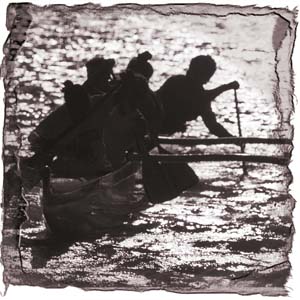
Photograph by Christopher Gardner
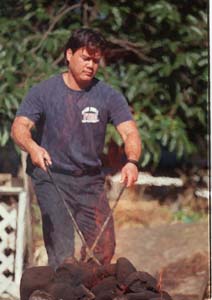 Fire Man: Island traditions remain strong with many Hawaiians, such as Jared Sniffen, above, a San Jose firefighter who recently had a lu'au with family and friends at Fire Station #14. To cook the traditional lu'au pig, he dug a pit and used lava rocks that have been in his family for two generations.
Fire Man: Island traditions remain strong with many Hawaiians, such as Jared Sniffen, above, a San Jose firefighter who recently had a lu'au with family and friends at Fire Station #14. To cook the traditional lu'au pig, he dug a pit and used lava rocks that have been in his family for two generations.
![[line]](/gifs/line.gif)
![[line]](/gifs/line.gif)
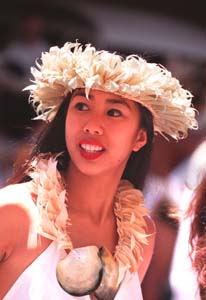 Swell Shells: An 'Ote'a Api dancer wearing a white pareu, mother-of-pearl necklace and hei fara (haku lei in Hawaii) on her head waits her turn to dance at Tahiti Fete.
Swell Shells: An 'Ote'a Api dancer wearing a white pareu, mother-of-pearl necklace and hei fara (haku lei in Hawaii) on her head waits her turn to dance at Tahiti Fete.
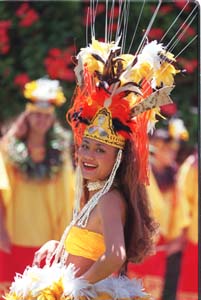 Feathered Friend: A performer from Kauai's Rohotu group struts her Tahitian stuff in the Ahupurotu Competition at the Tahiti Fete held in downtown San Jose.
Feathered Friend: A performer from Kauai's Rohotu group struts her Tahitian stuff in the Ahupurotu Competition at the Tahiti Fete held in downtown San Jose.
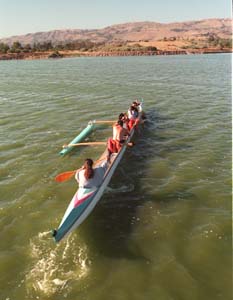 Tough Row: The Kamali'i 'O Ke Kai outrigger canoe club practices most summer evenings at San Jose's Lake Cunningham.
Tough Row: The Kamali'i 'O Ke Kai outrigger canoe club practices most summer evenings at San Jose's Lake Cunningham.
From the July 15-21, 1999 issue of Metro, Silicon Valley's Weekly Newspaper.